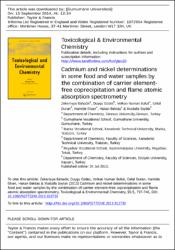Cadmium and nickel determinations in some food and water samples by the combination of carrier element-free coprecipitation and flame atomic absorption spectrometry
Access
info:eu-repo/semantics/closedAccessDate
2013Author
Bahadir, ZekeriyyaOzdes, Duygu
Bulut, Volkan Numan
Duran, Celal
Elvan, Hamide
Bektas, Hakan
Soylak, Mustafa
Access
info:eu-repo/semantics/closedAccessMetadata
Show full item recordCitation
Z. Bahadir, D. Ozdes, V. N. Bulut, C. Duran, H. Elvan, H. Bektas, Mustafa Soylak, “Cadmium and nickel determinations in some food and water samples by the combination of carrier element-free coprecipitation and flame atomic absorption spectrometry, Toxicological & Environmental Chemistry, 95, 737-746 (2013).Abstract
A procedure for separation and enrichment of Cd(II) and Ni(II) ions based upon carrier element-free coprecipitation by using an organic coprecipitant, 2-{4-[2-(1H-Indol-3-yl)ethyl]-3-(4-methylbenzyl)-5-oxo-4,5-dihydro-1H-1,2,4-triazol-1-yl}-N-(3-fluoro-phenylmethyliden) acetohydrazide, prior to their flame atomic absorption spectrometric detections has been developed. The effects of varied experimental conditions on the performance of the developed method such as pH, sample volume, amount of coprecipitating agent, etc. were evaluated in detail on the recovery of analyte ions, and the influences of some anions and cations were investigated. The limits of detection for Cd(II) and Ni(II) ions based on three times the standard deviation of the blanks (N: 10) were obtained as 0.70 g L-1 and 1.21 g L-1, respectively. The accuracy of the method was tested by analyzing a certified reference material and by spike tests. The method was applied to determine the levels of cadmium and nickel in stream and sea water, rice, red lentil, and wheat samples.


















